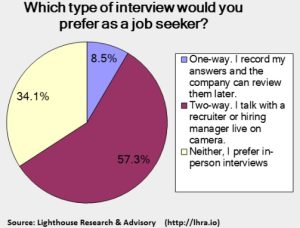GreenJobInterview, an early entrant in the video interview arena, is being acquired by Montage, one of its two leading competitors.
No financial details were disclosed in this morning’s announcement, which also included news that Montage had closed an $8 million funding round led by Plymouth Growth Partners with participation from repeat investors Baird Capital, Beringea and GCI.
Greg Rokos, who co-founded GreenJobInterview in 2008 with his brother Theo, said the acquisition of his Newport Beach, Calif. company is another in the continuing consolidation in the HR technology space.
“We were at a good point,” he said, noting that GreenJobInterview had to grown to be one of the leaders in video interviewing. HireVue , Montage and Spark Hire are the others. Among them, they claim a large share of the Fortune 1,000 as customers. Cumulatively, based on their own numbers, they have more than 4,000 customers.
As impressive as that is, the growth of video interviewing has slowed some in recent years. The Great Recession gave video interviewing a kickstart, as companies sought to cut recruiting costs. Instead of bringing in candidates from out of town, many companies turned to one or another of the video platforms for at least first round interviews.
“It’s growing,” Rokos said of the use of video. “But there hasn’t been the breakout… not the trajectory of a LinkedIn,” he added.
An OfficeTeam survey in 2012 reported that 63% of the 500 HR managers participating said their company often conducts video interviews. That represented a huge jump from the 14% who said that in 2011.
But in the intervening years, the percentage of companies conducting video interviews — live or pre-recorded — has largely stagnated. The few recent surveys have found differing percentages of use, but none have shown much growth beyond what the Robert Half group found:
- A 2015 Futurestep survey of 700 executives found 71% used real-time video to interview candidates.
- An Aberdeen whitepaper from October 2014 said 50% of its “Best in Class” companies were conducting video interviews versus 31% of all other.
- An ERE Media survey of TA leaders and recruiters found 37% reporting they never used video interviews and another 21% said they rarely conducted video interviews.
The most current survey (2016) by the National Association of Colleges and Employers said 55.3% of its member employers use video interviewing as a college recruiting tool. However, that percentage is suspect, since in 2015 only 31.6% said they did, and for most of the previous decade the percentage increased by only 5 or 6 points.
Rokos speculates that the growth of the use of video interview platforms — which is not the same as video interviewing — has been impacted by the improving economy and the widespread availability of free two-way video services.
Just last month Skype, which is owned by Microsoft, added a code editor feature to its free video conferencing tool. Facetime, a two-way video feature of Apple’s, runs on its laptops, iPads and phones.
That’s had an impact on penetration into the SMB market by the commercial video platforms even as it forces them to enhance their product well beyond merely facilitating two-way video.
At the same time, Rokos says there also seems to be less budget sensitivity to bringing in out of area candidates for interviews. Companies have loosened their recruiting budgets enough that hiring managers who want to meet face-to-face, can.
 That’s not necessarily a good thing. Rokos points out that passive candidates especially may not find it convenient to take off time from their current job to interview elsewhere.
That’s not necessarily a good thing. Rokos points out that passive candidates especially may not find it convenient to take off time from their current job to interview elsewhere.
Lighthouse Research & Advisory surveyed job seekers on this very question find that almost two-thirds of them prefer a video interview to meeting in-person.
